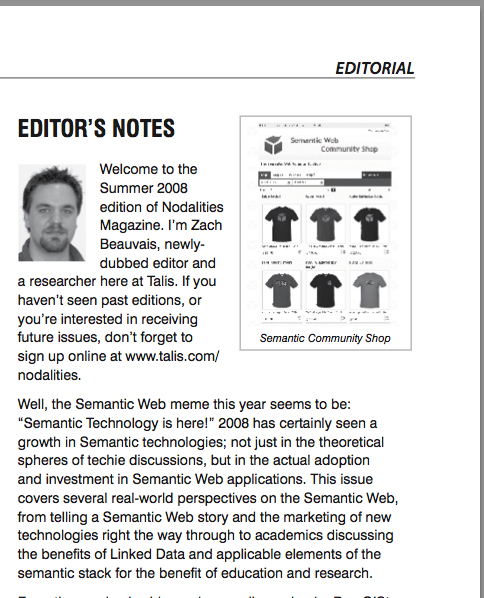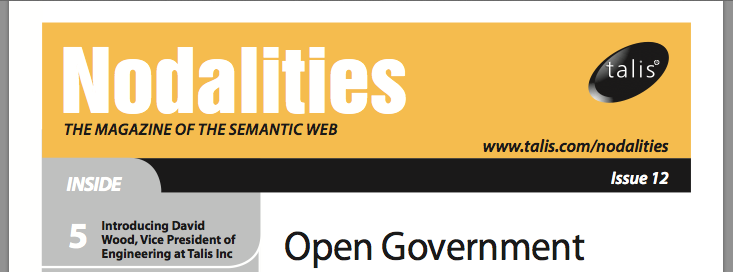Every aspect of society and economy that has been touched by the Web has been changed radically. Even the way we interact socially is very different to 15 years ago. … These changes are being brought about by the Web’s ability to link documents together into a single information space. The Semantic Web extends this to link anything and as such the potential for radical change in our society is vast.
–Ian Davis—Nodalities 2nd Ed
Every week, I used to receive a few emails along these lines:
Subject: Nodalities, I hope this is OK?
Hi Zach, I’ve attached my story for Nodalities, and would like to know what you think?
Best Regards,
Someone Awesome
For three years, I had the chance to read the stories of many of the Semantic Web’s most exciting developers before anyone else. I was allowed to tell them that I really enjoyed their story—and ask if we could cut it down from 5,000 words to a bit more like 1,000; you know, if you don’t mind?
Then, I would pull together a generous handful of these stories every couple months and ask our designers to put them between the thick, matte paper covers of what everyone in the office called Nodmag.
The magazine’s aim was to be the Semantic Web’s first regular industry publication. We were building a platform for sharing Linked Data and wanted to share news from across the whole industry. I had somehow ended up appearing in Nodalities’ second edition as a co-author with Ian Davis, discussing the Semantic Web as a blue-ocean opportunity.
Before the third issue, my colleague Paul Miller handed me the reigns, and I learned a hell of a lot in those first few months. I enjoyed asking people if they’d ever considered writing up their project in an article-like piece of prose. This in itself taught me much about collaborative projects, to see how many people were willing to put in extra time to write about their passion and share their skill. It also introduced me to some of the most articulate technologists, who often crystallised abstract and often staggeringly complicated ideas into a form anyone interested in the Web could appreciate.
Editing itself is something I found profoundly enjoyable, and I miss the chance to see the first version of an article, and to work through fixing punctuation and nudging syntax without altering the meaning – adding my own semantic layer to the semantic web. The most rewarding element was working with semantic web people who didn’t realize they could tell their story. With just a few nudges and hints, their enthusiasm won, and overpowered some restraints of self-conscious writing.
 I absorbed a lot of information about linking data and applying web technologies, and watched the story unfold from a slightly removed position. Our first articles, for example, tended to look forward—expecting proof-of-concepts and apps in-the-wild.
I absorbed a lot of information about linking data and applying web technologies, and watched the story unfold from a slightly removed position. Our first articles, for example, tended to look forward—expecting proof-of-concepts and apps in-the-wild.
Over time, the stories began to sound different in tone as they slowly shifted from expectation to sharing progress and discussing work underway. We also saw meticulous research from universities and science institutes. Although being a scholarly journal was beyond the general remit, many academics shared their findings with Nodalities’ audience, kindly writing at a level even I could understand.
At the beginning of 2011—amid some big changes at Talis—I took up the place as community manager in the data marketplace, Kasabi. As a startup, Kasabi really demanded full attention, and I could no longer commit to running the magazine. Also, despite doing the publishing several years, we had never pretended to be a proper publisher, and I had sincerely hoped Nodalities would be superseded by journalists whose coverage of our emerging industry should fare better than one blogging/community chap at a software company could do. So, I put together the last editor’s notes to appear next to a truly terrible portrait for the final issue in late spring, 2011.
I met incredibly interesting people, and editing is something I very much hope to have the chance to do again someday. I feel honoured to have been first to read these stories, and hope any influence I may have had didn’t get in the way of the developers’ voices.
Last week, following Talis’ major shift of direction, I felt nostalgic, and wanted to pour over some of the older copies of Nodmag. Alas, I found them missing. I’ve since heard that there are some plans to archive the site, and to have a home for the magazine somewhere, but in the meantime the back issues of Nodalities are available on github: github.com/beauvais/nodalities.
EDIT: Final Editor’s Notes
Nodalities has, for three years, told stories from around the ever-expanding sphere of Linked Data. As Editor, I have had the privilege of helping to tell those stories, to meet so many interesting people, and take part in the growth of the Linked Data community.
This will be Nodalities’ final edition.
At Talis, we have never been a media or publishing company–we build data platforms and applications–but Nodalities was created to help our community grow and give a voice to those joining and building with us. The magazine has fulfilled it’s purpose, and I am very happy for other media now to take responsibility for telling its stories.
As a final issue, I do not want to look back for context, but forward to new and emerging developments on the Web of Data. So, I have the added privilege of presenting a collection of stories with an emphasis on starting up for the final time.
If you would like to get in touch about any of these stories, or would like to catch up with me about what Talis is working on next, please feel free to contact me on zb@talis.com
Best,
Zach Beauvais
